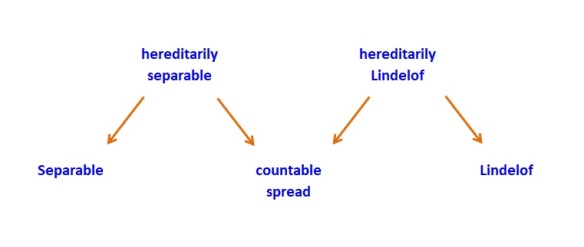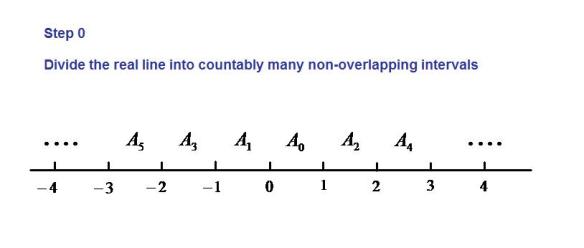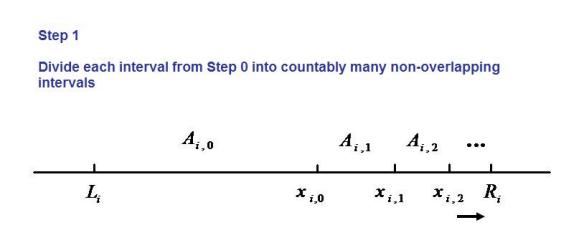This post puts a spot light on a little corner in the world of set-theoretic topology. There lies in this corner a simple topological statement that opens a door to the esoteric world of independence results. In this post, we give a proof of this basic fact and discuss its ramifications. This basic result is an excellent entry point to the study of S and L spaces.
The following paragraph is found in the paper called Gently killing S-spaces by Todd Eisworth, Peter Nyikos and Saharon Shelah [1]. The basic fact in question is highlighted in blue.
A simultaneous generalization of hereditarily separable and hereditarily Lindelof spaces is the class of spaces of countable spread – those spaces in which every discrete subspace is countable. One of the basic facts in this little corner of set-theoretic topology is that if a regular space of countable spread is not hereditarily separable, it contains an L-space, and if it is not hereditarily Lindelof, it contains an S-space. [1]
The same basic fact is also mentioned in the paper called The spread of regular spaces by Judith Roitman [2].
It is also well known that a regular space of countable spread which is not hereditarily separable contains an L-space and a regular space of countable spread which is not hereditarily Lindelof contains an S-space. Thus an absolute example of a space satisfying (Statement) A would contain a proof of the existence of S and L space – a consummation which some may devoutly wish, but which this paper does not attempt. [2]
Statement A in [2] is: There exists a 0-dimensional Hausdorff space of countable spread that is not the union of a hereditarily separable and a hereditarily Lindelof space. Statement A would mean the existence of a regular space of countable spread that is not hereditarily separable and that is also not hereditarily Lindelof. By the well known fact just mentioned, statement A would imply the existence of a space that is simultaneously an S-space and an L-space!
Let’s unpack the preceding section. First some basic definitions. A space is of countable spread (has countable spread) if every discrete subspace of
is countable. A space
is hereditarily separable if every subspace of
is separable. A space
is hereditarily Lindelof if every subspace of
is Lindelof. A space is an S-space if it is hereditarily separable but not Lindelof. A space is an L-space if it is hereditarily Lindelof but not separable. See [3] for a basic discussion of S and L spaces.
Hereditarily separable but not Lindelof spaces as well as hereditarily Lindelof but not separable spaces can be easily defined in ZFC [3]. However, such examples are not regular. For the notions of S and L-spaces to be interesting, the definitions must include regularity. Thus in the discussion that follows, all spaces are assumed to be Hausdorff and regular.
One amazing aspect about set-theoretic topology is that one sometimes does not have to stray far from basic topological notions to encounter pathological objects such as S-spaces and L-spaces. The definition of a topological space is of course a basic definition. Separable spaces and Lindelof spaces are basic notions that are not far from the definition of topological spaces. The same can be said about hereditarily separable and hereditarily Lindelof spaces. Out of these basic ingredients come the notion of S-spaces and L-spaces, the existence of which is one of the key motivating questions in set-theoretic topology in the twentieth century. The study of S and L-spaces is a body of mathematics that had been developed for nearly a century. It is a fruitful area of research at the boundary of topology and axiomatic set theory.
The existence of an S-space is independent of ZFC (as a result of the work by Todorcevic in early 1980s). This means that there is a model of set theory in which an S-space exists and there is also a model of set theory in which S-spaces cannot exist. One half of the basic result mentioned in the preceding section is intimately tied to the existence of S-spaces and thus has interesting set-theoretic implications. The other half of the basic result involves the existence of L-spaces, which are shown to exist without using extra set theory axioms beyond ZFC by Justin Moore in 2005, which went against the common expectation that the existence of L-spaces would be independent of ZFC as well.
Let’s examine the basic notions in a little more details. The following diagram shows the properties surrounding the notion of countable spread.
The implications (the arrows) in Diagram 1 can be verified easily. Central to the discussion at hand, both hereditarily separable and hereditarily Lindelof imply countable spread. The best way to see this is that if a space has an uncountable discrete subspace, that subspace is simultaneously a non-separable subspace and a non-Lindelof subspace. A natural question is whether these implications can be reversed. Another question is whether the properties in Diagram 1 can be related in other ways. The following diagram attempts to ask these questions.
Not shown in Diagram 2 are these four facts: separable hereditarily separable, Lindelof
hereditarily Lindelof, separable
countable spread and Lindelof
countable spread. The examples supporting these facts are not set-theoretic in nature and are not discussed here.
Let’s focus on each question mark in Diagram 2. The two horizontal arrows with question marks at the top are about S-space and L-space. If is hereditarily separable, then is
hereditarily Lindelof? A “no” answer would mean there is an S-space. A “yes” answer would mean there exists no S-space. So the top arrow from left to right is independent of ZFC. Since an L-space can be constructed within ZFC, the question mark in the top arrow in Diagram 2 from right to left has a “no” answer.
Now focus on the arrows emanating from countable spread in Diagram 2. These arrows are about the basic fact discussed earlier. From Diagram 1, we know that hereditarily separable implies countable spread. Can the implication be reversed? Any L-space would be an example showing that the implication cannot be reversed. Note that any L-space is of countable spread and is not separable and hence not hereditarily separable. Since L-space exists in ZFC, the question mark in the arrow from countable spread to hereditarily separable has a “no” answer. The same is true for the question mark in the arrow from countable spread to separable
We know that hereditarily Lindelof implies countable spread. Can the implication be reversed? According to the basic fact mentioned earlier, if the implication cannot be reversed, there exists an S-space. Thus if S-space does not exist, the implication can be reversed. Any S-space is an example showing that the implication cannot be reversed. Thus the question in the arrow from countable spread to hereditarily Lindelof cannot be answered without assuming axioms beyond ZFC. The same is true for the question mark for the arrow from countable spread to Lindelf.
Diagram 2 is set-theoretic in nature. The diagram is remarkable in that the properties in the diagram are basic notions that are only brief steps away from the definition of a topological space. Thus the basic highlighted here is a quick route to the world of independence results.
We now give a proof of the basic result, which is stated in the following theorem.
Theorem 1
Let is regular and Hausdorff space. Then the following is true.
- If
is of countable spread and is not a hereditarily separable space, then
contains an L-space.
- If
is of countable spread and is not a hereditarily Lindelof space, then
contains an S-space.
To that end, we use the concepts of right separated space and left separated space. Recall that an initial segment of a well-ordered set is a set of the form
where
. A space
is a right separated space if
can be well-ordered in such a way that every initial segment is open. A right separated space is in type
if the well-ordering is of type
. A space
is a left separated space if
can be well-ordered in such a way that every initial segment is closed. A left separated space is in type
if the well-ordering is of type
. The following results are used in proving Theorem 1.
Theorem A
Let is regular and Hausdorff space. Then the following is true.
- The space
is hereditarily separable space if and only if
has no uncountable left separated subspace.
- The space
is hereditarily Lindelof space if and only if
has no uncountable right separated subspace.
Proof of Theorem A
of the first bullet point.
Suppose is an uncountable left separated subspace. Suppose that the well-ordering of
is of type
where
. Further suppose that
such that for each
,
is a closed subset of
. Since
is uncountable, the well-ordering has an initial segment of type
. So we might as well assume
. Note that for any countable
,
for some
. It follows that
is not separable. This means that
is not hereditarily separable.
of the first bullet point.
Suppose that is not hereditarily separable. Let
be a subspace that is not separable. We now inductively derive an uncountable left separated subspace of
. Choose
. For each
, let
. The set
is the set of all the points of
chosen before the step at
. Since
is countable, its closure in
is not the entire space
. Choose
.
Let . We claim that
is a left separated space. To this end, we need to show that each initial segment
is a closed subset of
. Note that for each
,
is an open subset of
with
such that
and thus
(closure in
). Then
is an open subset of
containing
such that
. It follows that
is open in
and that
is a closed subset of
.
of the second bullet point.
Suppose is an uncountable right separated subspace. Suppose that the well-ordering of
is of type
where
. Further suppose that
such that for each
,
is an open subset of
.
Since is uncountable, the well-ordering has an initial segment of type
. So we might as well assume
. Note that
is an open cover of
that has no countable subcover. It follows that
is not Lindelof. This means that
is not hereditarily Lindelof.
of the second bullet point.
Suppose that is not hereditarily Lindelof. Let
be a subspace that is not Lindelof. Let
be an open cover of
that has no countable subcover. We now inductively derive a right separated subspace of
of type
.
Choose and choose
. Choose
and choose
such that
. Let
. Suppose that points
and open sets
,
, have been chosen such that
and
. The countably many chosen open sets
,
, cannot cover
. Choose
. Choose
such that
.
Let . It follows that
is a right separated space. Note that for each
,
and the open set
does not contain
for any
. This means that the initial segment
is open in
.
Lemma B
Let be a space that is a right separated space and also a left separated space based on the same well ordering. Then
is a discrete space.
Proof of Lemma B
Let such that the well-ordering is given by the ordinals in the subscripts, i.e.
if and only if
. Suppose that
with this well-ordering is both a right separated space and a left separated space. We claim that every point is a discrete point, i.e.
is open for any
.
To see this, fix . The initial segment
is closed in
since
is a left separated space. On the other hand, the initial segment
is open in
since
is a right separated space. Then
is closed in
. It follows that
must be open since
.
Theorem C
Let is regular and Hausdorff space. Then the following is true.
- Suppose the space
is right separated space of type
. Then if
has no uncountable discrete subspaces, then
is an S-space or
contains an S-space.
- Suppose the space
is left separated space of type
. Then if
has no uncountable discrete subspaces, then
is an L-space or
contains an L-space.
Proof of Theorem C
For the first bullet point, suppose the space is right separated space of type
. Then by Theorem A,
is not hereditarily Lindelof. If
is hereditarily separable, then
is an S-space (if
is not Lindelof) or
contains an S-space (a non-Lindelof subspace of
). Suppose
is not hereditarily separable. By Theorem A,
has an uncountable left separated subspace of type
.
Let such that the well-ordering represented by the ordinals in the subscripts is a right separated space. Let
be the symbol for the right separated well-ordering, i.e.
if and only if
. As indicated in the preceding paragraph,
has an uncountable left separated subspace. Let
be this left separated subspace. Let
be the symbol for the left separated well-ordering. The well-ordering
may be different from the well-ordering
. However, we can obtain an uncountable subset of
such that the two well-orderings coincide on this subset.
To start, pick any in
and relabel it
. The final segment
must intersect the final segment
in uncountably many points. Choose the least such point (according to
) and call it
. It is clear how
is chosen if
has been chosen.
Suppose is a limit ordinal and that
has been chosen for all
. Then the set
and the set
must intersect in uncountably many points. Choose the least such point and call it
(according to
). As a result, we have obtained
. It follows that T with the well-ordering represented by the ordinals in the subscript is a subset of
and a subset of
. Thus
is both right separated and left separated.
By Lemma B, is a discrete subspace of
. However,
is assumed to have no uncountable discrete subspace. Thus if
has no uncountable discrete subspace, then
must be hereditarily separable and as a result, must be an S-space or must contain an S-space.
The proof for the second bullet point is analogous to that of the first bullet point.
We are now ready to prove Theorem 1.
Proof of Theorem 1
Suppose that is of countable spread and that
is not hereditarily separable. By Theorem A,
has an uncountable left separated subspace
(assume it is of type
). The property of countable spread is hereditary. So
is of countable spread. By Theorem C,
is an L-space or
contains an L-space. In either way,
contains an L-space.
Suppose that is of countable spread and that
is not hereditarily Lindelof. By Theorem A,
has an uncountable right separated subspace
(assume it is of type
). By Theorem C,
is an S-space or
contains an S-space. In either way,
contains an S-space.
Reference
- Eisworth T., Nyikos P., Shelah S., Gently killing S-spaces, Israel Journal of Mathmatics, 136, 189-220, 2003.
- Roitman J., The spread of regular spaces, General Topology and Its Applications, 8, 85-91, 1978.
- Roitman, J., Basic S and L, Handbook of Set-Theoretic Topology, (K. Kunen and J. E. Vaughan, eds), Elsevier Science Publishers B. V., Amsterdam, 295-326, 1984.
- Tatch-Moore J., A solution to the L space problem, Journal of the American Mathematical Society, 19, 717-736, 2006.
Dan Ma math
Daniel Ma mathematics
2018 – Dan Ma





